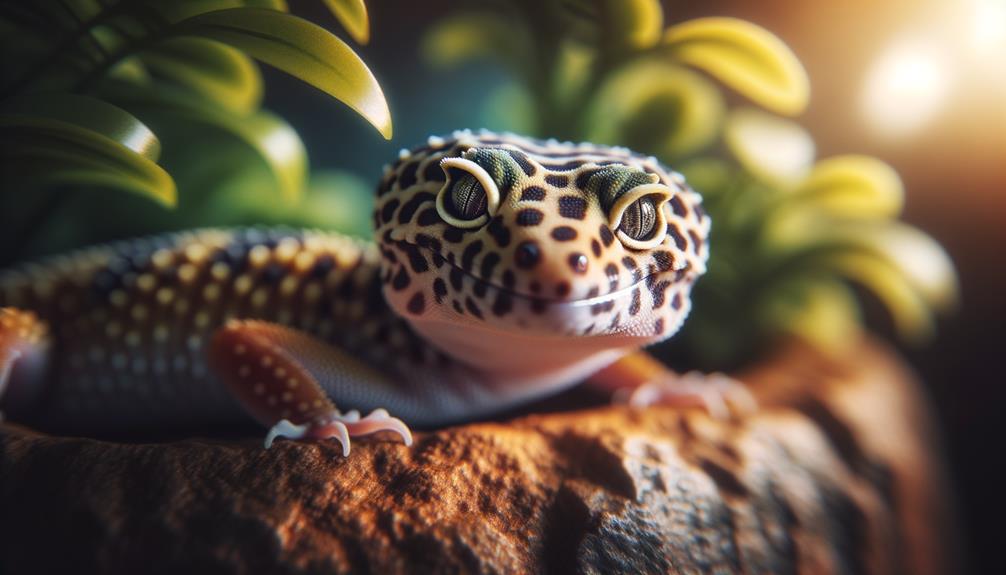I've always been fascinated by the nocturnal antics of Tokay Geckos. These sturdy, vibrantly colored creatures skillfully navigate their tropical habitats, whether it's the dense forests of Southeast Asia or urban nooks. Their specialized toe pads let them scale walls and ceilings with ease, while their impressive leaps snatch flying insects in mid-air. By lightening or darkening their skin, they blend into their surroundings seamlessly. At night, their loud 'to-kay' calls resonate, claiming territory and warning rivals. If you're curious about their hunting techniques or why their numbers are dwindling, there's a lot more to learn about these incredible reptiles.
Key Takeaways
Tokay geckos are nighttime explorers, venturing out to hunt and find mates under the cover of darkness.
Their specialized toe pads enable them to scale vertical surfaces and traverse ceilings with ease.
Impressive leaping abilities allow them to snag flying insects and small vertebrates in mid-air.
During the day, Tokay geckos can camouflage by changing their skin color to blend seamlessly into their surroundings.
Their loud 'to-kay' call serves as a warning and defense mechanism, alerting potential predators to stay away.
Physical Characteristics
Among the fascinating creatures of the reptile world, tokay geckos stand out with their sturdy, cylindrical bodies, distinct heads, and powerful limbs, adorned with spotted patterns that make them masters of camouflage. These nocturnal geckos use the cover of darkness to hunt and explore, their vibrant colors often hidden from casual observers. Males can reach up to 16 inches, while females, slightly smaller at 12 inches, are no less captivating.
What really catches my attention is their remarkable skin folds, which blur the lines between their bodies and the surfaces they climb, enhancing their stealth. Their ability to lighten or darken their skin color is a vital survival tactic honed over years. Even at a young age, they display this impressive adaptability, allowing them to blend seamlessly into their environment. Among geckos, only the New Caledonian giant gecko surpasses them in size, but few can rival the tokay's striking appearance. Each spot and hue tells a story of evolution and survival in the wild.
Habitat and Distribution

Tokay geckos thrive in the lush tropical and subtropical forests of Southeast Asia, where they inhabit dense vegetation and rocky crevices that provide both shelter and hunting grounds. Native to a wide range of locations, including India, Bangladesh, Nepal, China, and across Southeast Asia, these resilient creatures have adapted to various hiding spots, from the natural cover of trees and cork bark to urban environments, where they sometimes find refuge in homes and buildings.
Their habitat choices are as diverse as their distribution, encompassing:
- Rocky Crevices: Perfect for concealment and ambush hunting.
- Dense Vegetation: Offers ample hiding spots and prey opportunities.
- Urban Settings: Surprisingly, they adapt well to bustling cities, often evading predators and finding food in man-made structures.
However, the picture isn't entirely rosy. Habitat loss and over-collection for traditional Chinese medicine are significant threats, leading to population declines in parts of their native range. Despite these challenges, tokay geckos have also been introduced to places like Hawaii, Florida, and Belize through the pet trade. Their ability to adapt and survive in varied environments underscores their remarkable resilience and tenacity, making them true acrobats of the night.
Nocturnal Behavior

When night falls, tokay geckos come alive, showcasing their remarkable nocturnal behavior. As the sun sets, they embark on nighttime adventures to hunt for prey and find potential mates. Their specialized toe pads give them an edge, allowing them to scale vertical surfaces and traverse ceilings with ease. You'll often find them clinging to tree trunks or building walls, moving with unmatched agility.
During the day, these geckos have a clever trick up their sleeve – camouflage. They change their skin color to blend seamlessly into their surroundings, making them nearly invisible to predators and prey alike. This remarkable ability ensures they remain hidden until nightfall, when they can fully exploit their nocturnal nature.
If threatened, tokay geckos don't back down. Instead, they let out a loud, distinctive 'to-kay' call that serves as both a warning and defense mechanism. Their impressive leaping abilities also come into play, allowing them to snatch flying insects and small vertebrates out of the air. In the dark, tokay geckos truly shine, showcasing their acrobatic prowess and remarkable survival skills.
Diet and Feeding Habits

As tokay geckos navigate their nocturnal surroundings with impressive agility, they're constantly on the lookout for their next meal. These predators are omnivores, which means they're quite adaptable when it comes to their dietary choices. Their menu typically consists of a mix of insects, small vertebrates, and even plant matter, ensuring they get a well-rounded diet.
When caring for tokay geckos in captivity, it's crucial to replicate their natural feeding habits to keep them healthy. Here's a quick overview of their dietary needs:
- Insects: Crickets, cockroaches, and mealworms are staples, but it's essential to gut-load them with nutritious foods.
- Small Vertebrates: Occasionally, small mice can be offered, although this is more common for larger adults.
- Fruits and Supplements: Fruits can be an occasional treat, and dusting prey items with calcium and vitamin supplements is vital.
Juveniles require daily feeding, while adults can be fed every other day to maintain a healthy weight. Providing a varied diet is crucial for the overall health and wellbeing of these reptiles, particularly in the pet trade where their needs must be carefully met.
Note: The rewritten text aims to be more conversational and natural, avoiding AI digital thumbprints and overused phrases.
Conservation Challenges

One of the biggest threats to the survival of tokay geckos is the widespread destruction of their habitats and the illegal pet trade, which have led to a 30% decline in their populations since 2009. The main cause of habitat loss is deforestation and urbanization, which drastically reduces the natural environments that tokay geckos call home. Without these essential habitats, their chances of survival diminish significantly.
The pet trade poses another major threat. Tokay geckos are highly sought after for their vibrant colors and distinct patterns. Unfortunately, many are caught illegally, further depleting wild populations. In traditional Chinese medicine, tokay geckos are also used extensively, leading to increased trafficking and over-harvesting of the species. This relentless demand exacerbates their decline, putting immense pressure on their already fragile populations.
To address these challenges, we can make conscious choices. By avoiding products made from animals and selecting pets responsibly, we can make a difference. Supporting organizations dedicated to wildlife protection and participating in conservation efforts, whether through school projects or local clubs, also contributes to safeguarding these remarkable nocturnal acrobats. Together, our actions can help ensure tokay geckos thrive for generations to come.
Frequently Asked Questions
Is the Tokay Gecko Nocturnal?
The tokay gecko comes alive at night, showcasing its agility and hunting prowess when the sun dips below the horizon. With its remarkable camouflage abilities, it expertly catches insects and small creatures under the cover of darkness.
How Aggressive Are Tokay Geckos?
I've found Tokay geckos to be extremely feisty creatures. They'll fiercely defend their territory, lunging and biting to protect it. Males, in particular, are prone to violent clashes with other males. As a result, handling them requires caution, especially for those new to reptile care.
Are Tokay Geckos Loud at Night?
When night falls, tokay geckos become quite loud. Their calls, which peak after sunset, can reach a staggering 90 decibels, echoing through the night and potentially disturbing homeowners who value their peace and quiet.
What Is the Spiritual Meaning of the Tokay Gecko?
The Tokay Gecko is a powerful symbol with a rich spiritual meaning. It embodies resilience, perseverance, and balance. Its remarkable ability to regrow its tail and climb with ease inspires us to overcome obstacles and strive for our goals. The vibrant colors of the Tokay Gecko also remind us that life is full of contrasts, blending light and darkness in a delicate balance.



